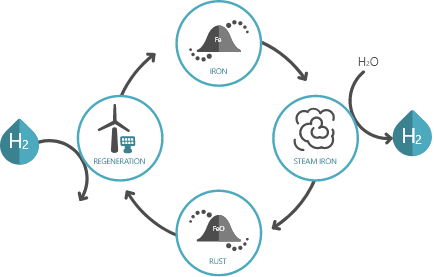Hydrogen presents significant potential in the energy transition due to its clean burning nature without greenhouse gas emissions. However, it comes with challenges. It is a highly flammable and unsafe gas, necessitating strict safety protocols for handling and storage. Additionally, storing hydrogen at usable densities requires either high pressures or very low temperatures, posing logistical and infrastructure challenges. Finding solutions to these safety, storage, and infrastructure obstacles is crucial for harnessing the full potential of hydrogen in the energy transition.

Fire and explosion
hazards

High pressure/low
temperature storage

Large energy losses
Breakthrough technologies are needed to really tackle the challenge of large scale energy storage. The solution of iron-based hydrogen storage is one such technology.
This solution offers an alternative option to store hydrogen in a safe way. In the so-called steam iron process, steam is reacting with iron to start oxidation. In this process hydrogen and rust are produced. Afterwards, the hydrogen can be filtered from the remaining steam and used for multiple purposes. The rust that is also produced in the steam iron process can be regenerated by means of carbothermal reduction, sustainable electrothermal reduction or by adding green hydrogen again. In this way, hydrogen can be stored in a circular system.
SOLID has been developing Iron-based Hydrogen storage for over two years, starting in 2021 with nothing more than a paper, and now with a fully working proof-of-concept system called the Steam Iron Reactor 1, capable of both storing and releasing one kilogram of hydrogen. In addition to that, the groundworks have been laid out for the IRHYS-ecosystem with the completion of the techno-economic feasibility study in 2022. In the coming years, SOLID hopes to scale up the technology, in order to test it at an industrial level


The cycle has no CO2 emissions.

The IRHYS cycle can be reused endlessly.

Iron is three times more energy dense than hydrogen.

Iron is the cheapest metal on earth.

Existing infrastructure without any energy loss.

The most abundant element on earth based on mass.

Minimal explosion and fire hazards.

Already an established commodity hence relatively stable prices.
“Developing the ecosystem for the Iron-based Hydrogen Storage technology”
© 2024 Team Solid. All Rights Reserved. Ontwikkeld door WEBZIES.